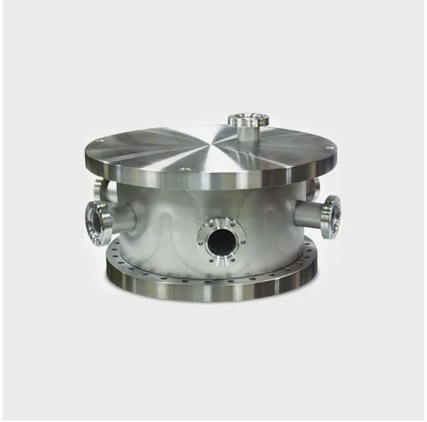Fundamentals of High-Quality Vacuum Chambers
Defining Key Components in Vacuum Chamber Design
Getting to know what makes up a vacuum chamber isn't just important it's absolutely necessary if we want safe and accurate results across different uses. Let's look at three main parts first there's the actual chamber itself, then the seals, and finally those feedthrough components. Each part matters a lot when keeping that vacuum tight. Take the chamber body for example most manufacturers go with strong stuff like stainless steel or special alloys because these materials can handle the stress of low pressure environments plus they deal well with temperature changes. The seals? Well they stop air from sneaking in which would ruin everything obviously. And feedthroughs let us send electricity or connect other systems without letting outside air mess up our vacuum conditions inside the chamber.
Picking out the correct materials matters a lot when building these parts, especially in tough industries such as aerospace manufacturing and pharmaceutical production where things just cant fail. Vacuum chambers need to last through years of service without breaking down, which means finding materials that can stand up to constant pressure fluctuations and whatever else gets thrown at them during daily operations. Stainless steel comes up again and again because it resists rust so well and holds together under stress. That makes sense considering how many times these systems get used in places where there's no room for error.
Hermetically Sealed Environments & Pressure Resistance
Sealing systems completely from outside elements is really important for how vacuum chambers work properly. These seals stop contaminants from getting in and help keep everything running smoothly over time. When working with sensitive materials or delicate manufacturing processes, maintaining that pure environment matters a lot. Just think about semiconductor fabrication or pharmaceutical production where microscopic particles could ruin entire batches. Even tiny gaps or weaknesses in the seal can cause big problems down the road. We've seen cases where seemingly small leaks resulted in wasted resources, failed experiments, and costly equipment damage. That's why proper sealing isn't just nice to have it's absolutely essential for anyone relying on vacuum technology for critical applications.
How well a vacuum chamber can handle pressure differences matters a lot in its overall design. The math behind this needs to be spot on if the chamber is going to work properly within the pressure range needed for whatever job it's doing. Most manufacturers follow established industry rules when building these systems. Groups like ASME and ISO have set out detailed specs that cover everything from materials to construction methods. Sticking to these guidelines makes all the difference when it comes to getting consistent results no matter what kind of pressure conditions the chamber faces. This attention to standard compliance protects not just the manufacturing process itself but also ensures the final product meets quality expectations.
Role of Vacuum Chambers in Ensuring Operational Safety
Contamination Prevention in Sensitive Applications
Vacuum chambers really matter when it comes to keeping things clean in applications where even tiny bits of dirt can ruin everything. Take semiconductors or pharmaceuticals for instance those industries need absolutely spotless conditions because any impurity might wreck their products completely. Most companies stick to strict cleanroom protocols and invest heavily in advanced techniques just to keep their vacuum systems working properly so nothing gets into them. We've seen plenty of cases across different fields where contamination problems caused massive losses sometimes millions worth of damage right down the drain. With all that at risk, nobody can afford compromised vacuum chambers anymore they simply must maintain that level of purity if they want their sensitive operations to work correctly day after day.
Structural Integrity for Hazard Mitigation
Keeping vacuum chambers structurally sound helps stop dangerous leaks and possible explosions from happening. Manufacturers achieve this strength through thorough testing during design phase, running computer models alongside physical stress tests to see if they can handle extreme situations. There are plenty of real world examples where good engineering prevented disasters when things could have gone wrong. Take aerospace applications for example, where properly built vacuum systems make all the difference between mission success and catastrophic failure. When companies prioritize safety against hazards, it makes sure operations stay both secure and dependable across many different sectors that rely on quality vacuum chambers.
Precision Engineering in Vacuum Chamber Manufacturing
Micrometer-Level Tolerances for Critical Systems
Getting down to micrometer level tolerances matters a lot in situations where keeping a vacuum intact is absolutely essential. CNC machining technology helps manufacturers hit those tough specs, which means better reliability and performance from their products. Take space exploration for example the industry demands rock solid precision because even the smallest mistake can spell disaster. Components used in spacecraft typically need to be accurate within just a few microns. Why does this matter so much? Because when we talk about satellites going up or missions heading out to other planets, there's no room for error. The kind of accuracy required isn't just about making something look good it's actually what keeps these important projects running smoothly without catastrophic failures.
Material Selection for Thermal & Mechanical Stability
Picking the correct material for vacuum chambers matters a lot when it comes to keeping things stable thermally and mechanically across different situations. When looking at options, people need to consider how much the material expands when heated, its overall strength, and whether it stands up to corrosion over time. Titanium and top quality stainless steel tend to be go-to choices because they hold up really well under stress. These metals don't expand too much when temperature changes occur, plus they resist rusting even after years of use. For instance, when comparing stainless steel against aluminum in actual tests, stainless typically wins out in terms of holding together at elevated temps. This makes all the difference in settings where temperatures swing back and forth constantly throughout operations.
Quality Control Protocols for Reliable Performance
ISO 9001-Certified Production Processes
ISO 9001 certification is pretty much essential for building strong quality management systems when manufacturing vacuum chambers. When manufacturers follow these globally accepted standards, they create solid frameworks that boost product reliability while keeping customers happy long term. Getting certified means going through some tough stuff like frequent audits, meticulous record keeping, and always looking for ways to improve operations. These aren't just box-ticking exercises either; they show genuine dedication to making consistently good products time after time. Companies that actually go through the process tend to see real changes in how they operate day to day. Take aerospace firms for example, many report cutting down on material waste by around 30% within their first year post-certification. Others notice faster turnaround times because everyone knows exactly what quality expectations look like from start to finish. The bottom line? ISO 9001 isn't just paperwork it's a game changer for serious manufacturers wanting to stand out in competitive markets.
Helium Leak Testing & Vacuum Endurance Validation
Testing for helium leaks remains critical when checking how well vacuum chambers actually work, since any tiny breach can mess up their whole function. The reason this method works so well lies in helium itself - those tiny atoms slip right through cracks that bigger molecules would miss completely. When combined with tests that check how long chambers hold up under pressure, we get a pretty good picture of what they can handle over time. Most companies running these tests track their results closely, and there's plenty of real world evidence out there showing what difference proper testing makes. Some manufacturers have seen their defect rates drop significantly after ramping up their helium leak detection efforts alongside endurance checks, which goes to show just how much impact thorough quality control has on keeping equipment performing reliably day after day.
Industry-Specific Applications of Advanced Vacuum Systems
Aerospace: Simulating Space Environment Conditions
Vacuum chambers are really important in aerospace work because they simulate the tough conditions found in space during actual missions. Inside these chambers, engineers create environments where spacecraft can be tested under extreme temperatures and pressure levels just like what they'd face out there among the stars. These tests help make sure that when a spacecraft finally launches, it won't break down halfway through its mission. NASA and other space agencies have collected plenty of evidence showing how effective vacuum technology is for validating spacecraft designs. Take the Mars Rover as an example it went through rigorous thermal vacuum testing so all its systems would survive the brutally cold conditions on Mars. Looking at how often vacuum chambers get used for these kinds of tests tells us just how vital they are to making sure our spacecraft actually work once they leave Earth's atmosphere.
Semiconductor Manufacturing: Particle-Free Processing
Vacuum chambers play a vital role in semiconductor manufacturing where even microscopic particles can ruin entire batches. These chambers use sophisticated methods like Physical Vapor Deposition (PVD) to keep everything spotless inside. Contamination remains a major headache for manufacturers, with industry reports showing losses running into several billion dollars each year from just tiny specks getting into sensitive materials. For companies making semiconductors, spending money on good vacuum systems isn't optional it's necessary to avoid those costly mistakes and keep components working properly. As chipmakers continue developing smaller devices packed with more power, they need better vacuum solutions than ever before because there's simply no room for error when dealing with nanoscale fabrication processes.
Pharmaceuticals: Sterile Filling & Packaging Solutions
Vacuum chambers play a critical role in aseptic processing for pharmaceutical filling and packaging operations. They maintain sterile conditions that meet strict industry standards. The chambers basically create clean environments free from contaminants, which cuts down on contamination risks when making drugs. Regulatory bodies like the FDA have specific rules governing these manufacturing spaces, and vacuum tech is essential for staying compliant. Looking at what happens when companies fail to follow these guidelines shows why compliance matters so much it can lead to expensive product recalls and put patients at risk. Vacuum chambers matter a lot whether they're used for complicated filling tasks or just keeping packages sterile. Their presence directly affects both the quality and safety of medicines produced in this sector.
FAQ
What materials are commonly used in vacuum chamber construction?
Common materials include stainless steel and specialized alloys due to their ability to withstand low pressure, varying temperatures, and resist corrosion.
Why is hermetic sealing important in vacuum chambers?
Hermetic sealing prevents contamination and ensures consistent performance by maintaining the purity of processes in precision-driven industries.
How do vacuum chambers prevent contamination in sensitive applications?
Vacuum chambers minimize contamination by employing stringent cleanroom standards and sophisticated methodologies to safeguard vacuum integrity.
What is the role of helium leak testing in vacuum chambers?
Helium leak testing is crucial for verifying the absence of leaks in vacuum chambers, ensuring they can withstand prolonged operational demands without compromising functionality.

